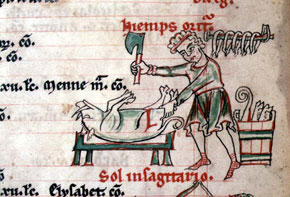French School, (13th cent.)

-
November: Killing the Pig
- (Ms 54. f.6r)
- (13th cent.), tempera colors and ink on vellum
- Bibliotheque Municipale, Besancon, France
-
Editor’s Note:
In 1098 Abbot Robert and a group of his French monks from Molesme, who were dissatisfied with contemporary monasticism and sought solitude and seclusion in woods south of Dijon, founded the Cistercian Order. They wished to follow a harsher and more disciplined way of life, according to a literal interpretation of the Rule of St Benedict. The Cistercians did not see themselves as starting a new system of monastic life but rather as restoring the pure form of the Benedictine life.
The Cistercian Order was the most important of the new religious orders that developed in western Europe in the late eleventh century in response to movements for reform in the Church. Cistercians – also known as White Monks – dominated the spread of new monastic foundations in Europe, rapidly moving from Burgundy where the order began throughout France, Britain and Ireland.
The Cistercians had their critics, as well as their admirers, but their rigorous lifestyle attracted more than it deterred. Within fifty years of their foundation the white monks had taken Europe by storm, and by the mid-seventeenth century there were more than 1500 Cistercian houses in Europe, stretching from Scandinavia to Sicily.
About the Artist
Cistercian Psalter, French School, (13th cent.) The Cistercian Psalterwas part of a collection purchased by the National Library in 1963 from the Clifford Family of Ugbrooke Park, Chudleigh, Devon, England. The Clifford Collection comprised 75 English and European manuscripts, including ten medieval manuscripts, and more than 10,000 volumes of rare books and pamphlets.
Cistercian Psalter, Breviary and Missal manuscript is on vellum with part in double columns, 32 lines to the page and the greater part in single column of 26 lines to the page, rubricated in red and blue. There are fine marginal flourishes in red and blue ink, calligraphic capitals in red and blue. Pages are 142 x 110 mm. contained in a fine contemporary German binding of stamped vellum over champered oak boards with remains of original brass clasps.
The stamped binding comprises a central rectangle of interlaced flower sprays surrounded by seven compartments of New Testament scenes, each with blind-stamped title. The lower cover is similarly stamped with the figures of Saints; the manuscript written and signed at end by Brother Henry, monk of Fürstenfeld, Diocese of Freising, 1306.
